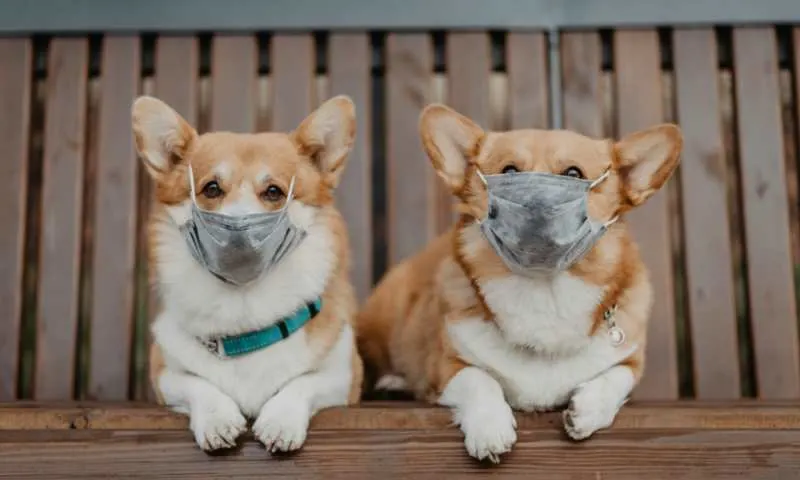There are many things you need to look out for as a dog owner. Sure, your dog needs to be taught to behave, and you need to make sure the cuddling levels are satisfactory, especially when talking about Corgis.
But let’s talk about what your main priority should be at all times – health!
The main subject at hand today is skin conditions and health, to be more specific. Like in humans, skin is the largest organ in dogs. And taking good care of it is of utmost importance.
So how about we take a look at some skin conditions in Corgis. Do Corgis have sensitive skin?
Well, while there are breeds that have severe skin problems when compared to our favorite fluffy dogs, that still doesn’t minimize the fact that these fluffers don’t have the toughest skin out there!
So let’s talk about what kind of problems and conditions you can expect, and what you should do if you’re faced with one of them.
Of course, it’s important to mention that no two Corgis are the same. You can even have a pair of closely related Corgis and still have one with susceptible skin while the other manages to survive every allergy season like it’s nothing.
But for the sake of the sensitive ones, let’s get this thing started!

Skin Conditions In Corgis: An Overview
Do Corgis have skin issues, and if they do, why does it happen?
Well, many things can affect the health of your Corgis skin. While you can have control over some of them, others are passed down genetically. The most severe of which is Dermatomyositis, but more on that in a minute.
If we steer away from the inherited conditions, we will find out that the main culprit for Corgis skin-problem predispositions is that luscious double coat that they can’t seem to take off.
And you can’t say that they don’t try with all that darn shedding they do year-round.
Well, as it turns out, the excessive shedding and the double coats all do serve a purpose, even though they do some harm as far as the skin is concerned. The Corgi has a shorter but double-coated fur that grows and sheds all year long.
That’s because they’ve served, as a breed, as herders on the hills of Wales as far back as three thousand years ago. And if you’re not familiar with the climate in the region, here’s a little crash course:
The winters are harsh, the springs are beautiful but windy, the summer gets hot, and you get a lot of rain during fall.
With all those seasons so well represented, Corgis managed to adapt to virtually everything that they faced.
The double coat isolates the body very well during winter and does the same job in the summer heat. The wind has a tough time reaching the skin, and the rain might as well not even try, as the topcoat might get a bit drizzled, but the bottom coat remains bone dry.
So, where’s the harm?
Well, it’s during those beautiful springs in Wales where Corgis started to figure out that they may not have thought of everything. Allergens get caught up in those hairs like crazy!
And when the breed as a whole get’s exposed to so many allergens year in and year out, the immune system is bound to slip up at some point.
Not only that, but once the Corgi started gaining worldwide popularity, the allergens became international! Now let’s just get something straight:
The breed doesn’t suffer any severe or life-threatening consequences from the allergies – but that doesn’t mean that the symptoms can’t get serious.
Allergies, and the symptoms that they bring with them, can help develop a condition called atopic dermatitis, among others.
Corgis are famous for licking and biting at itches, so much so that they usually have bald spots or even draw blood. So it doesn’t help that they often suffer from conditions like atopic dermatitis, as one of the common symptoms are hot (itchy) spots all over the body that will make your Corgi go crazy.
So do Corgis have dry skin? Does that harsh coat not let in enough moisture or something?
Well, no, even though it does seem that these are patches of dry skin, they’re actually not. These patches are infected by bacteria that are making the skin red, itchy, and scaly.
Let us explain by firstly elaborating on those allergies. What skin allergies are Corgis prone to as a breed? Is there a way to keep them protected while they’re young?
Let’s figure it out!

Skin Allergies In Corgis: Things To Keep In Mind
There is a heck of a lot of things that will make a Corgi’s skin itch in nature.
We already mentioned that they have a bit of a tough time during spring, as their double-coated furs grab on to anything and everything. That includes allergens like dust, pollen, grass, etc. The standard allergenic suspects, as with any of us.
But, as usual in these situations, there is more to this story than just a walk in the park.
Corgis are sensitive creatures, not just when it comes to their environment but also the foods they eat. That may seem a bit crazy; we already talked about them working on hills and farms for thousands of years!
So why the heck are they so sensitive suddenly?
Well, here’s the thing. While yes, Corgis did have allergy problems that caused some skin conditions during the breed’s lifetime in Wales. And yes, those problems did worsen when they started traveling worldwide, but it’s not just the pollen and the dust.
Think about what the Corgi has been eating for all those years.
There just wasn’t much variety in the Corgis diet for it to adapt to new foods that may harm it in any way. That’s actually the case for a lot of breeds:
For generations, they’re used to the same old meals day after day, and then suddenly, one offspring goes to the new world and starts eating things that are unimaginable to its tiny little body.
Some research shows that there are more cases of dietary allergies than those caused by the environment. That goes to show how important it is for your puppies to have a healthy and balanced diet.
And please notice that we said puppy, as we’re talking about the young Corgis, not about those already having their allergies set and ready to go.
If your Corgi, in particular, is prone to specific allergies because of something they inherited – there is a chance that you’ll be able to break the chain while they’re still young!
Here’s what we mean:
If you manage to avoid foods that are more likely to cause harm to your Corgi from a young age, their immune system may just find a way to build its needed defense against allergies.
The obvious problem with this tactic is that there is no way to know your puppy’s sensitivity, but you can pick and choose what foods you provide.
It’s imperative, especially for puppies, to eat a high-quality meal every day that will give their body the means to develop into healthy, fully-grown Corgis. It doesn’t matter what kind of food you choose – dry, wet, or fresh. Just make sure it’s the good stuff!
Now, some people will swear by any of these foods.
Some will say that dry foods are the best because they have all the necessary ingredients; this way you don’t have to worry about your dog not getting a specific nutrient. Heck, if you pick a high-quality brand, not only will your Corgi be getting all the nutrients, they’ll be top of the line as well!
After the dry food folk come the people who swear by wet foods. The ordeal is pretty much the same, but we suppose that they do have a point about the food not being dry. All jokes aside, this variant really can be very healthy if you know how and what to choose.
And last but not least, the religion of serving your puppy fresh foods. “It’s the holy grail of food choices,” is what the people who advocate it will make you believe.
And let’s get something straight; they’re not that far off point. As long as you make sure to put in every necessary ingredient, the meal that you prepare can be pretty much perfect for your dog. Well, if you know your nutrition, that is.
That brings us to the problem with fresh foods:
You need to do a lot of research and make a great effort if you want the fresh meal you’ve created to go one on one with the dry and wet foods. Top-quality brands have a research facility dedicated to this stuff, after all!
If you decide to go with fresh foods, just make sure to do the research and figure out what your dog’s body needs.
So why is it that we’re telling you all this?
Well, as we mentioned, there is a chance that your dog’s scratching and manic licking may be connected to the food you’re giving it.
If you notice that your dog is constantly scratching, to the extent that the young one is getting bald spots on its body and experiencing hair loss around the eyes, nose, and feet – there are allergies to deal with there.
Contacting your vet is the first thing you need to do; they will run some tests to try and figure out the cause of all the trouble. After this, they will give you a step-by-step guide for the nutrition that your dog needs.
But we suggest researching the subject as much as possible from the get-go.
Your vet knows best; there are no two ways about it. But it will help you – and them – if you know your dog’s nutrition, and it may even help prevent allergies in the first place.
No two dogs are the same, sure, but there are steps that can be taken, nonetheless.
Avoiding certain meats, buying foods rich in fish oil and omega-3’s has proven to be a heck of a helping hand in controlling allergies and the consequences they have on dogs.
And one last thing we have to mention about nutrition:
Don’t change up your dog’s food too often. If you can, don’t change it at all. Switching quickly between food types and sources can aggravate your dog’s stomach, and besides that, it has proven to be bad for dogs prone to allergies.
That’s because their bodies need a lot of time and energy to get used to the new food and process it completely. For young puppies, that’s time away from fighting possible dangerous allergens.
Combine these two and put a dog prone to food sensitivity in the middle – and you’ve got a recipe for all kinds of conditions, skin included.
So how is it that you can deal with itchy skin in Corgis?
Well, if it’s food-related, you make sure to know exactly what their body needs, and you do your best to provide it! You’d be surprised at how many health issues can be taken care of with the proper diet.

Atopic Dermatitis In Corgis
Alright, so we’ve covered allergies. We know by now that Corgis can be allergic to pollen, dust, grass, and everything else that can get stuck in their thick double coats.
We also figured out that they can be pretty darn sensitive to certain kinds of foods. That’s all fine, and we all understand it.
But what is it about allergies that make your dog develop a skin condition that can make them harm themselves by scratching like they’ve gone mad?
Well, there are many types of allergies. And these types can cause different symptoms. Just like with humans, some allergies attack the respiratory system, others the skin, etc.
What likely happened here is that some form of bacteria started inhabiting the skin, causing a couple of problems.
Firstly, the skin being infected means that it is trying to get rid of the bacteria at all times. It’s just like when the system develops a high temperature to battle a virus. The skin sends more blood cells to the area, withholds some elements, and multiplies others to beat the invading organism.
That’s actually a pretty great system, but it does have side effects. The main one that we’re going to talk about right now is itching:
The skin becomes dry as the bacteria doesn’t allow it to moisturize itself. The combination of that and the blood cells that are on assignment make the Corgi itch terribly.
On that note, your Corgi does need the predispositions to become allergic to something. When we said that you could try and slow the process down at a young age, we meant that it would help if they manage to avoid the allergens that can be dangerous to them specifically.
At one point or the other, they will develop some kinds of symptoms to said allergens, no matter how careful they are.
But with enough attention to detail, they can be minimized.
The flaky, dry, reddish skin will show in a couple of common spots that make it evident that you’re dealing with atopic dermatitis. Hot spots at the nose, behind the ears, feet, armpits, groin, and at the top of the tail are clear signs that you need to look out for here.
Sometimes the condition will cause hair loss, but that symptom is usually not found at all the hot spots but around the nose, eyes, and ears.
Unfortunately, because of their dense double coats, most people only notice a problem once the Corgi licks and bites at the skin. That causes even more inflammation and even leaves bald spots at these places, as we already mentioned.
Your vet will make an educated guess as to what allergens are at fault. And while you should leave it to them, there are some signs that you can look out for – and hopefully, react in time.
Inhalant And Contact Allergens
The rule of thumb for locating allergens that you Corgi could have inhaled or gotten in contact with is this:
- If the problems don’t stop after spring and continue to affect your dog all year long, you’re dealing with a possible dust or mold problem in your household. The solution is similar to when a child develops allergies. Get a good air filtration system, and keep your puppy away from problematic areas.
- If the problems only occur seasonally, you’re dealing with pollen; it’s as simple as that. What’s not so simple is dealing with this, as you can’t just clean up the pollen from your house. But with the proper medication during the problematic seasons, the symptoms can generally be reduced to a minimum.
Food Allergens
While this may sound simple on paper, figuring out exactly what foods your puppy is allergic to is a time-consuming process. There’s no way to pinpoint the exact foods that could be problematic.
A bit of detective work is going to be needed.
What further complicates the matter is that dogs can develop allergies over time; it’s not just something that happens when they’re introduced to new food.
Firstly you need to take out the foods currently in your Corgi’s diet, one by one. The effect of the food that is causing the problem can take up to eight weeks to disappear.
That means that you won’t know if you got rid of the right food for at least two months.
Because of this, some people prefer to go with just hypoallergenic foods to avoid the whole process and try to eliminate the symptoms sooner rather than later.
There are other causes like Staphylococcus Hypersensitivity or fleas, but these should only be handled by your vet. So there’s no need for us to spend too much time discussing these.

Dermatomyositis In Corgis
Dermatomyositis is an inherited condition that is passed down from generation to generation. While something like atopic dermatitis usually appears between years one and three, this peculiar condition tends to show up as early as six months or, in some cases, right after birth.
That means that you’ll probably know whether or not your Corgi is affected before its first birthday.
Symptoms
There are many symptoms of this condition, and their intensity can vary over time. Here’s what you can look out for:
- Lesions around and on the face
- Lesions on the tail
- Ulcer at the bottom of their feet
- Losing nails
- Scaling skin
- Dandruff
- Hair loss
- Red, inflamed skin
- Muscle atrophy (in rare cases)
Like we already mentioned, the conditions get inherited, so there are no outside factors that you can “take care of” to help control its intensity. But just like with any canine skin condition, there are steps that you can take to make it more comfortable for your puppy.
For instance, hypoallergenic foods are a great way to control and minimize the effect of any skin problem that your Corgi may be suffering from currently. These foods or diets can’t cure anything, sure – but they do help with making it easier for your dog.
That brings us to one of the more essential parts of this condition:
Dermatomyositis is unfortunately not curable. No medication has been found that can help your puppy completely get rid of the condition but don’t worry. Your vet will take steps to minimize the symptoms.
While Dermatomyositis can be severe in some breeds, the symptoms are not as dangerous in Corgis. Seeking professional help is still necessary, though. If not treated, the symptoms can become severe over time.
Because of this, it’s essential to spot the signs at an early age, so you can learn on time how to help your Corgi lead a healthy and happy life!
Now, back to the hot spots in Corgis. With the condition not being as severe in the breed, are there any places where the lesions will appear on Corgis, in particular?
No, the hot spots on Corgis are the same as in any other breed. Labradors and Border collies might have the worst of it, but as far as symptoms go, you’ll spot them in the same places in all dogs!

Final Words
And here we are, we’ve reached the end of this little lesson. You probably found this article while searching for answers to simple questions like do Corgis get dry skin or do Corgis have skin problems.
Well, the answer is, as you can see, a bit more complicated than that.
No skin issue is just a simple rash that came out of nowhere; there is always an underlying condition that should be addressed. Now, sure, you don’t need to become a veterinarian to take care of your Corgi, but some basic knowledge is necessary, and that’s what we tried to achieve here.
So we hope that we’ve answered some of your questions and that you found the things you were looking for in this guide.
Taking care of a puppy is never easy, especially if it has any sort of health issue. But we can surely tell you one thing – it’s completely worth it!
Learn More: Do Corgis Have Allergies? What Are Corgis Allergic To?

